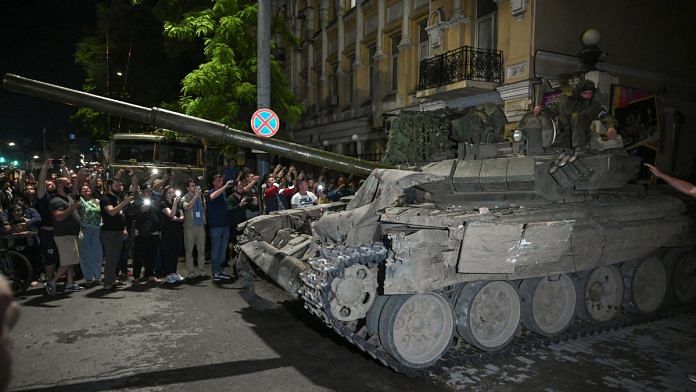New Delhi: Yevgeny Prigozhin, head of the Wagner Group, a private military company, claimed Saturday that he had taken control of the Russian city of Rostov-on-Don. Russia President Vladimir Putin called the group’s rebellion “armed mutiny”.
By evening, however, Prigozhin’s troops had begun withdrawing, said media reports. Reuters quoted Prigozhin as saying in a video, “In 24 hours, we got to within 200 km of Moscow. In this time, we did not spill a single drop of our fighters’ blood.”
“Understanding … that Russian blood will be spilled on one side, we are turning our columns around and going back to field camps as planned,” he said.
While the Wagner Group gained prominence with its involvement in Russia’s invasion of Ukraine in 2022, it has been active since 2014. The group has also operated in African countries, Syria, the Central African Republic, and Mali. It has been designated a transnational criminal organisation by the United States.
In the light of the armed rebellion, here’s a timeline of the Russian invasion of Ukraine where the group has played a pivotal role.
24 February 2022: Russia launches a full-scale invasion of Ukraine.
25 February: Ukrainian President Volodymyr Zelenskyy and team react to rumours of top leaders fleeing the country by filming a video in central Kyiv, assuring the nation, “We’re here.”
25-28 February: Russian forces capture the border town of Chernihiv and advance towards Kyiv.
4-11 March: Russian forces advance further into Ukraine, capturing strategic cities and towns such as Kharkiv, Donetsk, and Luhansk.
12-31 March: Russia continues its offensive, targeting other regions of Ukraine and causing significant damage and loss of life such as in the bombing of a theatre and a maternity hospital in Mariupol.
Also read: Putin sees himself as a tsar. He’s even repeating their deadly mistakes
1-7 April: Russian forces pull back from Kyiv, and evidence of a civilian massacre in the town of Bucha surfaces.
8-30 April: Ukrainian forces start reclaiming territory in the northern part of the country. Moskva, the flagship of Russia’s Black Sea Fleet, sinks. While Ukraine claims responsibility, Russia attributes it to fire of unknown origin.
1-15 May: Russian forces continue to shell Ukrainian cities and towns. Ukraine receives military aid from several countries, including India, the United States and Canada.
16-31 May: The conflict escalates further. The international community condemns Russia’s actions and imposes sanctions.
8-30 June: Ukrainian forces launch a counter-offensive in the Donbas region, recapturing several towns and cities. Russian forces sustain heavy losses and are forced to withdraw from the Kharkiv region. The United Nations General Assembly passes a resolution holding Russia responsible for the damage caused to Ukraine and demanding reparations.
8 July: Russian President Vladimir Putin warns that the war could drag on until the “last Ukrainian is left standing”. Russian forces have occupied most of the Luhansk region.
22 August: Russian forces make some progress in pushing north from the occupied southern city of Kherson towards Mykolaiv. Ukraine’s Defense Minister Oleksii Reznikov calls for additional weapons and tighter sanctions against Russia.
1-15 September: Ukrainian forces make further gains in the Donbas region, pushing Russian troops back and reclaiming additional territory. Russia flees the Kharkiv region.
16-30 September: Russia launches a major offensive, aiming to regain control of the territories lost to Ukraine. Putin also announces ‘partial mobilisation’ which leads to protests and exodus of men of fighting age from the country.
1-15 October: Russian forces seek to cripple Ukraine’s energy infrastructure. Using missiles and drones, it attacks Ukraine’s power facilities, leaving large areas in the country without power and water. On the Russian side, the Crimea Bridge, the only bridge connecting Russia with the Crimean peninsula, is damaged.
12 November: Ukrainian city of Kherson liberated.
30 November: The European Union announces plans to establish a special court to investigate war crimes committed by Russia in Ukraine. Russia withdraws from the Kherson region, and Ukrainian forces reclaim territory in the Donbas region.
21 December: Ukrainian President Zelenskyy visits the US, meets President Biden. He addresses the US Congress during his visit.
26 December: An update from the United Nations High Commissioner for Human Rights records 17,831 civilian casualties in Ukraine from 24 February.
31 December: Ukraine faces new Russian strikes, and both countries exchange prisoners of war.
22 January, 2023: Russian forces attempt an offensive in Zaporizhzhya and Donetsk regions.
23 January: Germany decides to provide Leopard 2 tanks to Ukraine. Biden assures Ukraine of 31 M1 Abram tanks.
20 February: US President Joe Biden visits Kyiv, his first since the war began a year ago. Biden says, “One year later, Kyiv stands. Ukraine stands. And Democracy stands.”
20 March: Fighting persists in Bakhmut, Marinka, and Avdiivka. Russian forces advance in Bakhmut, but no significant territorial gains are reported.
10 April: Over 100 prisoners of war exchanged between Ukraine and Russia.
26 April: China plans to send representatives for ceasefire talks in Ukraine.
27 April: Russia targets the Ukrainian city of Mykolaiv in a missile attack.
24 May: Fighting persists in the Donetsk region, with President Zelenskyy visiting troops on the front line.
25 May: Ukraine to receive F-16 fighter jets from the US; The Wagner Group withdraws from Bakhmut.
27 May: Ukraine claims to have shot down missiles and drones in an attack; Russia summons US diplomats over comments of NSA Jake Sullivan on Crimea being a part of Ukraine.
8 June: Ukrainian forces launch a major operation against Russian-held territories.
23-24 June: Prigozhin calls for an armed rebellion against Russia. His fighters advance towards Moscow but retreat by evening.
Also read: Modi-Biden went beyond pomp and show to build trust. India-US must keep the promise now



